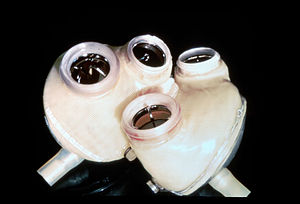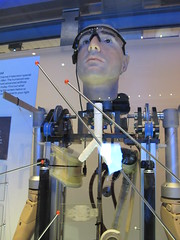 |
| Courtesy of Flickr |
“Astronaut Steve Austin, a man barely alive. But we can rebuild him. We have the technology.”
Or so the story goes in the
TV series starring Lee Majors that ran from 1974-1978. The stuff of fiction in the 20th
century, during the past few years many of the innovations portrayed in the
original series have gone from science fiction to science fact. There are now such things as prosthetic arms
and hands with tactile
sense, rudimentary bionic eyes that help the blind see,
and cochlear implants that help the deaf hear.
While we don’t yet have the ability to equip amputees with fully
functional legs that can go from zero to sixty in five seconds, we can offer
robotic exoskeletons that can help paraplegics regain the ability to walk on
their own. Plus there are other
man/machine concepts that are either in the prototype phase or on the drawing
board that can amp up the capabilities of us mere mortals. In this week’s blog, we will take a look at
these technologies, as well as the ramifications of enhanced human beings who
will soon make Colonel Austin seem as antiquated as much of the technology of
the 1970s.
Medical
Bionic Implants/Artificial Organ Market (Vision Bionics/Bionic Eye, Brain
Bionics) Worth $17.82 Billion by 2017 - New Report by Markets and Markets
The medical bionic
implant (artificial organs) industry has witnessed a myriad of technological
advancements over the past two decades.
It includes vision bionics, ear bionics, orthopedic bionics, heart
bionics, and neural/brain bionics. Medical bionics in pipeline include wearable
artificial kidney, bio-lung, and artificial pancreas. http://www.prweb.com/releases/medical-bionic-implant/market/prweb11241748.htm
Bionic Limbs Will One Day Sense Textures Under Human Feet
| English: Photograph of the implanted portion of a cochlear implant. The specific device shown is manufactured by Advanced Bionics. (Photo credit: Wikipedia) |
It sounds like
something straight out of science fiction: artificial limbs that not only move,
flex, and feel like their flesh counterparts, but also respond directly to
one's thoughts and even translate sensory feedback -- the feeling of grass
beneath one's feet or the sensation of a limb floating in space -- straight
back to the brain.
Thanks to an
aggressive push in funding from the US military in an effort to the improve the
lives of injured veterans, those advancements are no longer such farfetched
dreams. While the idea of "Blade Runner"-level prosthetics is still a
far-off fantasy, impressively capable, thought-controlled bionic limbs are now
a modern-day reality thanks to pioneering research between the Rehabilitation
Institute of Chicago (RIC), DARPA, and a growing sector of companies developing
the next generation of artificial limbs.
| Artificial heart: JARVIK-7 Heart, provided to the National Heart, Lung and Blood Institute (NHLBI) by the University of Utah. (Photo credit: Wikipedia) |
What Devices Will You be Using in Your Golden Years?
With an aging
population and billions of dollars at stake it is obvious that artificial limbs
and organs are a growing trend that is the next logical evolutionary step. While some people have ethical dilemmas with
creating replacement parts for the human body, the technology is anything but
new. During the past few decades
everything from hip and knee replacements to laser eye surgery has become
routine. Transplant
surgery isn't even
considered all that radical a procedure in the twenty first century, although organ
rejection hasn't quite been licked.
So why not construct replacement parts using all our available
technology? If it wasn't for the fact
that we couldn't figure out how to connect artificial limbs to our nervous
system, Steve Austin's would already be here. However, according to a recent article in the
Wall street Journal, this conundrum could soon be a thing of the past.
“In an advance that could eventually
improve the mobility of thousands of people living with amputations,
researchers said a 32-year-old man successfully controlled movements of a motorized artificial leg using only his own thoughts. Aided by sensors receiving impulses from
nerves and muscles that once carried signals to his missing knee and ankle, the
patient was able to climb and descend stairs and walk up and down inclines much
as he could with a natural leg, based on directions that came from his brain.
Importantly, he was able to flex the device's ankle, enabling a near-normal
gait, something not possible with current prosthetics.” http://online.wsj.com/news/articles/SB10001424052702304795804579097570008603700
Meet Frank N. Stein
| 'Bionic Man' (Photo credit: Rain Rabbit) |
Of course with
nearly two thirds of the human body capable of being simulated by prosthetics
it was only a matter of time before someone decided to hardwire them together
to create the first artificial human.
The first to attempt the feat was a pair of English researchers. Amazingly enough, their creation, named
Frank, came in not at $6 million mark but only $1 million. Of course as they say, you only get what you
pay for. No matinee idol, Frank is
nonetheless a TV star, since his creation was chronicled on, "The Incredible
Bionic Man," premiering Sunday (Oct. 20) on the Smithsonian Channel at 9
p.m.
The brainchild of robotic pioneers, Rich
Walker and Matthew Godden, their bionic man was assembled from a cornucopia of
artificial organs and prosthetic body parts that had been donated by labs from
around the world. According to the
documentary, Frank was modeled after Bertolt Meyer, a Swiss psychologist who
wears a bionic hand. Of course Frank
doesn't stop there. He also sports
everything from a wrist, ankles and feet to an artificial lung, trachea,
pancreas, spleen, kidney and heart that pumps artificial blood through an
artificial circulatory system. He also
has a brain that purportedly can mimic a number of human functions, including
speech recognition and production all of which are assisted by a cochlear
implant. Frank sees courtesy of a
retinal prosthesis.
| Neural interfaces for prosthetics (Photo credit: SandiaLabs) |
To support his prosthetic legs, the bionic man wears a
robotic exoskeleton dubbed "Rex," made by REX Bionics in New Zealand.
His awkward, jerky walk makes him more like Frankenstein than ever.
While Frank’s abilities are more akin to the Tin Man than Paul Newman, he can carry on a conversation since he comes equipped with a sophisticated chatbot program. Another thing that makes people want to engage Frank in conversation is the fact that while his body is more stickman than human, his prosthetic face is all too human-like. In fact, it is an exact replica of Bertolt Meyer.
In previous article,
I wrote about bionic technology (like the kind in Star
Trek episodes) aka cybernetics’
and augmented
reality like wearable
tech that can enhance our abilities. These technologies will alter how
humans work, live and behave as we adapt to live with enhanced capabilities.
The possibility
of having a walking, talking synthetic human does bring up a number of other
questions, such as how much body enhancement is socially acceptable? And what rights will an artificial human
being be granted? While I'm unable to answer these questions, I do have one suggestion. Why not go right to the horse’s mouth and ask
Frank, since he will be on display at the Smithsonian Air and space Museum in
Washington, DC through the remainder of the fall
season. Heck, I can think of a number of
politicians who could handily be replaced by Frank. But then that would present our bionic man
with a conundrum of his own.
 |
| Get your FREE COPY above! |
Until next time, enjoy your bionic life.
If you found this article useful, share it with your friends, families and co-works. If you have a comment related to this article, leave it in the comment sections below. If you would like a free copy of our book, "Internet Marketing Tips for the 21st Century," fill out the form Above in the right side bar
Since 1995, Carl Weiss has been helping clients succeed
online. He owns and operates several online marketing businesses,
including Working the Web to
Win and Jacksonville
Video Production. He also co-hosts the weekly radio show, "Working the Web to Win,"
every Tuesday at 4 p.m. Eastern on BlogTalkRadio.com.
Related articles





All I want to know is when will I be able to outrun my Toyota?
ReplyDeleteThis is why SEO experts still offer services to help you get your sites ranked.
ReplyDeleteRegular SEO content in the form of text is
easy to compare. If you start a website today you would be competing with
millions of other websites for attention or visibility.
Don't suffer the quality and performance of Tampa SEO using a low price.
Also visit my webpage ... marketing affiliates ()